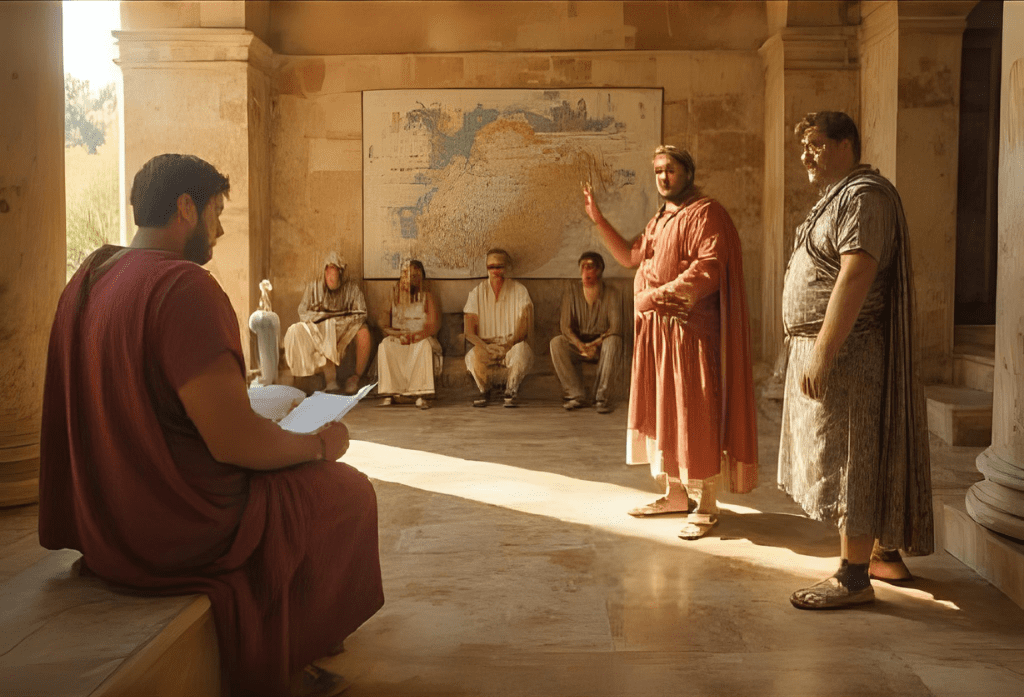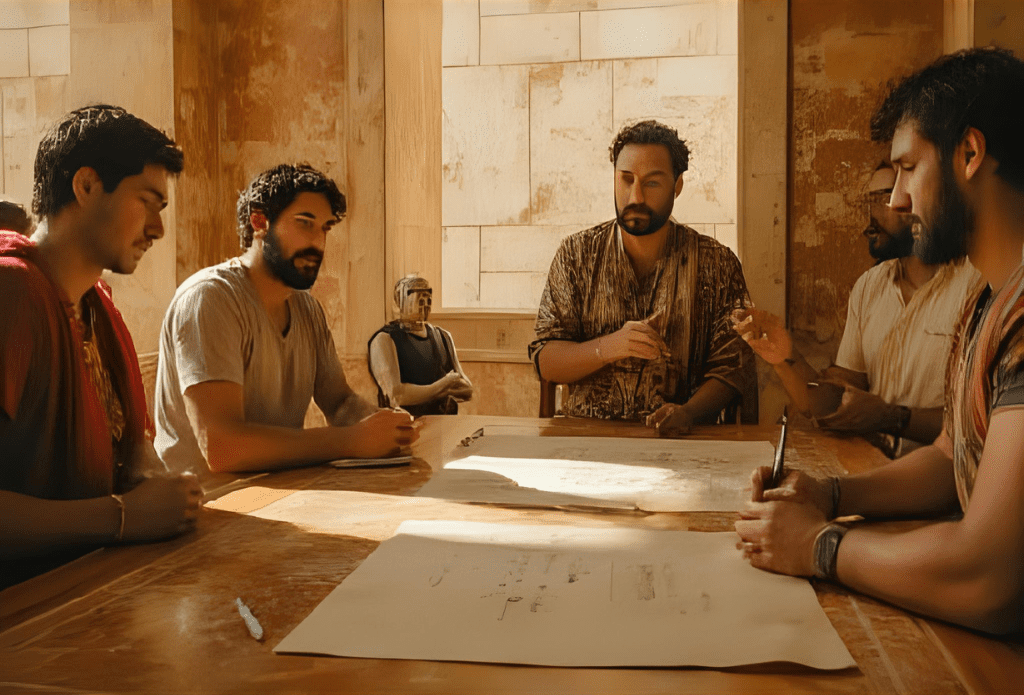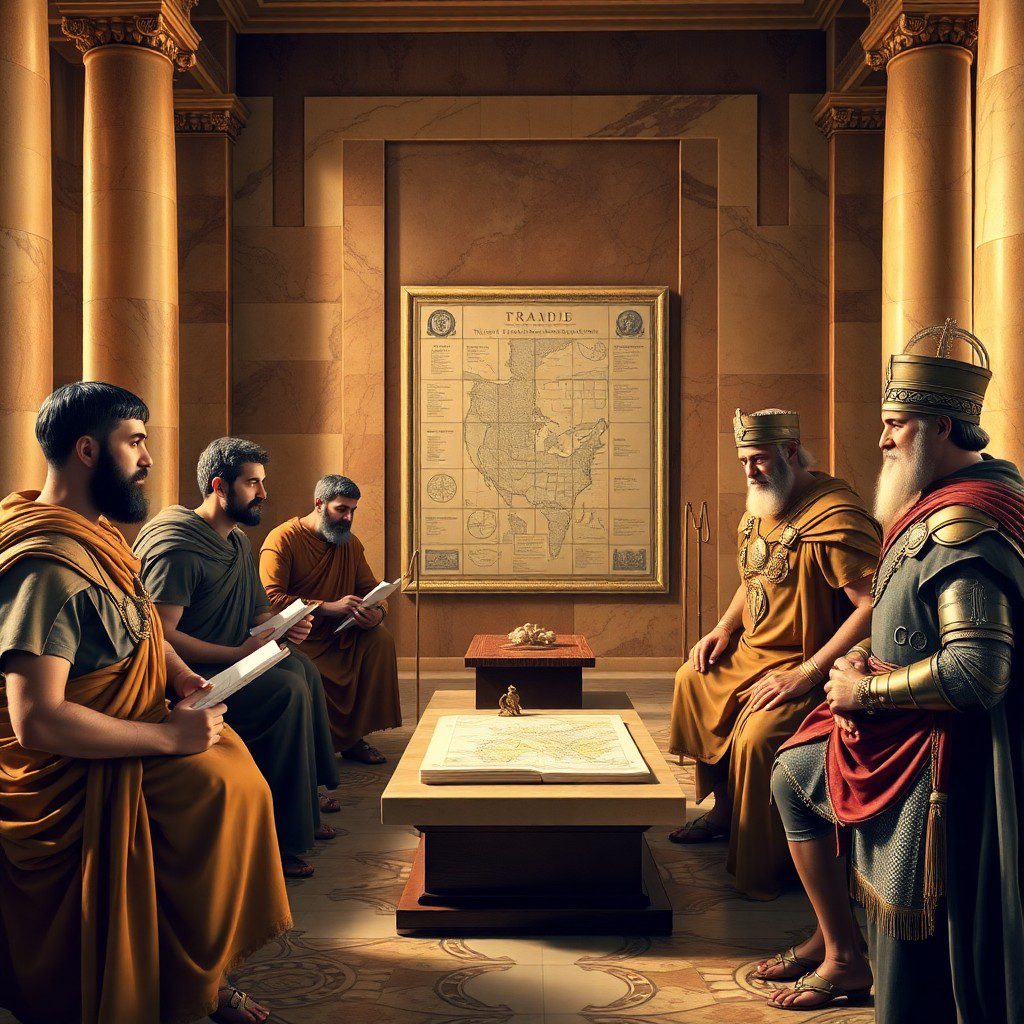When Modern Leadership Fails, Ancient Wisdom Prevails
The conference room falls silent as another quarterly report reveals declining metrics. The CEO’s latest management philosophy—the third this year—has failed to deliver results. Across industries and organizations, leadership volatility has become the norm rather than the exception. The average tenure of Fortune 500 CEOs continues to shrink, while employee trust in leadership remains at historic lows.
Meanwhile, the leadership principles established by Rome’s greatest emperors guided an empire spanning three continents for over five centuries. This wasn’t merely governmental longevity—it represented organizational stability and strategic continuity on an unprecedented scale.
The contrast between today’s leadership impermanence and the Roman model of enduring authority isn’t coincidental. It reflects fundamental differences in how power is conceptualized, how decisions are structured, and how leaders view their relationship with those they lead.
What made Roman imperial leadership so remarkably durable? And more importantly, what can today’s executives, managers, and aspiring leaders extract from these ancient approaches to solve thoroughly modern challenges?
The Augustus Principle: Building Systems That Outlast Individuals
When Octavian—later known as Augustus—became Rome’s first emperor, he inherited a republic in crisis. Decades of civil war had destroyed public trust in governance. Rather than imposing dramatic change, Augustus preserved the appearance of traditional structures while fundamentally reorganizing the power dynamics underneath them.
This transformation wasn’t merely political—it represented one of history’s most brilliant organizational restructurings. Augustus understood that lasting authority required institutional legitimacy, not just personal power.
The modern leadership parallel is striking. Organizations today regularly suffer through disruptive leadership transitions. Each new executive often dismantles predecessor systems to implement their vision, creating institutional whiplash. The result? Organizational knowledge is lost, employee trust erodes, and long-term initiatives rarely reach maturity.
Augustus demonstrated the opposite approach. He maintained the Senate’s ceremonial importance while creating new administrative systems that functioned regardless of who held specific positions. He established consistent communication channels between Rome and its provinces. Most significantly, he created a professional civil service structure where merit and expertise—not just political connections—determined advancement.
Consider how this applies to contemporary leadership challenges. When systems depend entirely on specific personalities, they become inherently fragile. The Augustus Principle suggests building institutional knowledge and procedures that transcend individual leaders—creating organizational continuity even through leadership changes.
Today’s application might involve documenting decision-making frameworks rather than just decisions, establishing governance systems that distribute authority appropriately, and creating succession planning that transfers not just titles but institutional wisdom.

Trajanic Expansion: Strategic Growth Without Overextension
Emperor Trajan expanded Roman territory to its greatest historical extent—yet unlike many conquerors, he understood the crucial difference between expansion and overextension. Each new territory was incorporated through systematic integration: establishing governance structures, building infrastructure, and creating economic connections to existing Roman provinces.
Modern organizations frequently fail to distinguish between growth and sustainable expansion. Acquisitions happen without cultural integration. New markets are entered without adequate infrastructure. Headcount increases without corresponding systems to maintain quality and communication.
The Trajanic model offers a powerful alternative. Trajan’s famous building programs weren’t vanity projects—they were strategic investments connecting new territories to Roman economic and administrative systems. Before expanding to new regions, he ensured existing territories were stable and self-sustaining.
For today’s leaders, this principle translates to several practical approaches. Before pursuing new markets or initiatives, ensure your current operations demonstrate excellence. Create integration systems before, not after, major organizational changes. Invest in infrastructure that connects different parts of your organization rather than allowing silos to develop.
Most importantly, recognize when additional expansion creates diminishing returns. Rome’s later decline came partly from defending territories that cost more to maintain than they generated in value—an ancient version of the modern failure to prune underperforming divisions or exit declining markets.

The Aurelian Philosophy: Leadership Through Personal Excellence
Marcus Aurelius—emperor, general, and Stoic philosopher—embodied perhaps the most profound Roman leadership principle: authority flows from personal discipline and ethical consistency. His private philosophical writings (later published as “Meditations”) reveal a leader constantly examining his own motivations, behaviors, and principles.
This self-reflective leadership stands in stark contrast to today’s environment where external metrics and public perception often drive executive behavior. Modern leadership development typically focuses on outward skills—communication techniques, strategic frameworks, negotiation tactics—while neglecting the internal discipline that sustains leadership through crisis.
The Aurelian approach to leadership begins with self-governance. Marcus famously wrote: “You have power over your mind—not outside events. Realize this, and you will find strength.” This wasn’t philosophical abstraction but practical leadership methodology. By developing internal discipline, Marcus maintained decision-making clarity during persistent crises including wars, plagues, and economic challenges.
Contemporary leaders face similar tests of character under pressure. Markets fluctuate, competitors emerge, technologies disrupt. The Aurelian philosophy suggests that leadership stability during volatility comes not from controlling external circumstances but from internal consistency—maintaining ethical frameworks and decision-making principles regardless of external pressures.
This approach manifests in several practical leadership behaviors: transparent communication during uncertainty, consistent application of principles even when expedient exceptions would be easier, and regular self-reflection on decisions and motivations. The leader who masters themselves before attempting to lead others establishes authority based on respect rather than merely positional power.
Hadrian’s Boundaries: The Strategic Power of Saying “No”
Emperor Hadrian implemented one of history’s most consequential strategic reversals. Where his predecessor Trajan had expanded aggressively, Hadrian withdrew from several overextended territories and literally built walls marking Rome’s limits. Hadrian’s Wall in Britain stands as the physical embodiment of his leadership philosophy: defining clear boundaries between what the empire would and would not attempt to control.
This willingness to establish explicit limitations represents a leadership quality chronically lacking in modern organizations. Today’s executives often pursue simultaneous initiatives across multiple fronts, diluting resources and attention. The pressure to demonstrate constant growth leads to strategic overextension—entering too many markets, launching too many products, or attempting too many transformations simultaneously.
Hadrian’s approach offers a powerful counterpoint. By explicitly marking boundaries, he concentrated Roman resources on making existing territories prosperous rather than continuously acquiring new ones. This consolidation created decades of stability and economic growth.
For today’s leaders, the principle translates into strategic clarity about what your organization will not do. This means establishing clear investment priorities, exiting non-core activities, and sometimes making the difficult decision to abandon initiatives that, while promising, would distract from central organizational strengths.
The modern application of Hadrian’s Boundaries includes: developing explicit criteria for which opportunities to pursue, creating governance processes that prevent resource dilution across too many projects, and regularly evaluating whether existing commitments align with core organizational priorities.

The Diocletian Restructuring: Adapting Systems to Scale
As Rome grew increasingly complex, Emperor Diocletian implemented a fundamental organizational redesign. He divided the empire into administrative units with clearer authority lines, established specialized roles rather than general governors, and created new coordination mechanisms between regions.
This restructuring acknowledged a fundamental leadership truth: systems that work at one organizational scale often fail at another. Many modern organizations face this same challenge—structures and processes designed for startups collapse under the weight of enterprise complexity, while enterprise systems often crush the agility needed in new ventures.
The Diocletian approach demonstrates how to evolve organizational structures to match current scale challenges rather than nostalgically maintaining systems that no longer fit. For today’s leaders, this means regularly reassessing whether decision-making processes, communication channels, and authority distributions still serve organizational needs as the organization grows or contracts.
Practical applications include: establishing different governance approaches for different business units based on their maturity, creating specialized roles as complexity increases rather than maintaining generalist positions, and implementing coordination mechanisms that preserve autonomy while ensuring alignment.
The Constantinian Alignment: Unifying Culture Around Core Principles
Emperor Constantine’s most consequential leadership decision—embracing Christianity as Rome’s favored religion—represents more than religious history. It demonstrates how effective leaders align cultural systems with governance structures. By establishing a unified cultural framework across diverse territories, Constantine created cohesion that transcended local differences.
Modern organizations struggle with similar alignment challenges. As companies expand across geographies or through acquisitions, maintaining cultural cohesion becomes increasingly difficult. The result is often fragmentation—different divisions operating with conflicting values, priorities, and norms.
The Constantinian approach suggests that organizational culture requires active leadership rather than passive evolution. This doesn’t mean homogeneity or suppressing diversity, but rather identifying core principles that transcend differences while allowing appropriate local variation.
For today’s leaders, this principle manifests in several practices: articulating clear organizational values and demonstrating how they apply across different contexts, creating cultural integration processes for new team members or acquired organizations, and aligning recognition and advancement systems with stated cultural priorities.
The key insight from Constantine’s example is that culture and structure must evolve together. When governance systems and cultural systems align, they mutually reinforce each other. When they conflict, they create organizational inconsistency that undermines authority.

The Fatal Flaws: Learning from Rome’s Leadership Failures
Roman imperial leadership wasn’t uniformly successful. The empire’s history includes catastrophic leadership failures that provide equally valuable lessons. Emperors like Commodus, Nero, and Caligula demonstrate how personal excess and arbitrary power destroy organizational trust. The repeated civil wars between competing claimants reveal the dangers of unclear succession planning.
These failures highlight several leadership principles through their negative examples. When leaders prioritize personal gratification over organizational health, decline inevitably follows. When succession planning becomes ambiguous, destructive power struggles emerge. When feedback mechanisms disappear and leaders become isolated from operational realities, decision quality deteriorates.
Modern organizations exhibit similar patterns when leadership accountability breaks down. Executive compensation that dramatically outpaces employee compensation creates the same organizational resentment that undermined imperial authority. Unclear succession creates the same paralysis and factional competition that repeatedly destabilized Rome.
The practical lesson involves establishing guardrails that prevent these leadership pathologies: governance systems that maintain appropriate checks on executive authority, transparent succession planning that prevents organizational paralysis during transitions, and feedback mechanisms that prevent leadership isolation.
Bridging Ancient Wisdom to Modern Application
The enduring value of Roman leadership principles lies not in their historical context but in their proven durability. These weren’t theoretical frameworks but practical governance approaches tested across centuries and diverse challenges. Their longevity offers validation rarely found in modern management theories that rise and fall with each business cycle.
Today’s leaders can translate these principles into contemporary practice through several approaches:
Build Institutional Memory
Like Augustus preserving knowledge through administrative structures, modern organizations need systems that maintain continuity through leadership changes. This means documenting not just decisions but decision frameworks, creating governance mechanisms that transcend individual leaders, and developing succession processes that transfer institutional wisdom, not just titles.
Expand Strategically, Not Impulsively
Trajan’s methodical integration of new territories offers a model for sustainable organizational growth. Before pursuing new markets or initiatives, ensure existing operations demonstrate excellence. Create integration processes before, not after, acquisitions or expansions. Invest in connective infrastructure rather than allowing organizational silos to develop.
Lead Through Personal Excellence
Marcus Aurelius demonstrated that leadership authority flows from personal discipline and ethical consistency. In practical terms, this means maintaining decision-making principles regardless of external pressure, transparently communicating during uncertainty, and regularly reflecting on your leadership motivations and impacts.
Establish Clear Boundaries
Hadrian’s willingness to define what Rome would not do offers a model for strategic clarity. Develop explicit criteria for which opportunities to pursue. Create governance processes that prevent resource dilution across too many initiatives. Regularly evaluate whether existing commitments align with core organizational strengths.
Adapt Systems to Scale
Diocletian recognized that organizational structures must evolve as complexity increases. This means regularly reassessing whether decision processes, communication channels, and authority distributions still serve organizational needs as you grow. Different business units may require different governance approaches based on their maturity and challenges.
Align Culture with Structure
Constantine demonstrated how governance systems and cultural frameworks must reinforce each other. Articulate clear organizational values and demonstrate their application across contexts. Create cultural integration processes for new team members or acquired organizations. Ensure recognition and advancement systems align with stated cultural priorities.
The Imperator’s Perspective: Leadership as Stewardship
Perhaps the most profound Roman leadership principle was the concept of leadership as stewardship rather than personal advancement. The most effective emperors viewed themselves as caretakers of institutions greater than themselves. They measured success not by personal enrichment but by the stability and prosperity they created.
This perspective stands in stark contrast to contemporary leadership models often focused on short-term metrics, personal brand building, or quick transitions to higher positions. The Roman model suggests leadership legitimacy comes from improving what you lead, not merely occupying the position.
For today’s leaders, this means asking different questions: Will this organization be stronger after my leadership than before it? Am I building systems that will continue functioning when I’m gone? Does my leadership create conditions where others can succeed beyond my tenure?
The emperors who answered these questions successfully—Augustus, Trajan, Hadrian, Marcus Aurelius—are remembered as history’s great leaders. Those who viewed leadership positions merely as platforms for personal gratification accelerated Rome’s eventual decline.
The choice between these leadership approaches remains as relevant today as it was two millennia ago. And while empires may have given way to corporations and institutions, the fundamental principles that sustain or undermine authority remain remarkably consistent across the centuries.
The Roman Emperor’s playbook offers not just historical interest but practical wisdom for anyone seeking to lead with lasting impact. Its principles have already outlasted one empire. They may well outlast our current organizations too.

